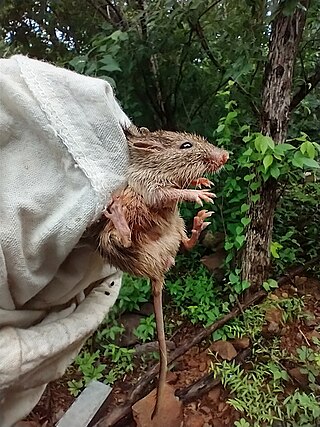
Peromyscus is a genus of rodents. They are commonly referred to as deer mice or deermice, not to be confused with the chevrotain or "mouse deer". They are New World mice only distantly related to the common house and laboratory mouse, Mus musculus. From this relative, Peromyscus species are distinguished by relatively larger eyes, and also often two-tone coloring, with darker colors over the dorsum (back), and white abdominal and limb hair-coloring. In reference to the coloring, the word Peromyscus comes from Greek words meaning "booted mouse". They are also accomplished jumpers and runners by comparison to house mice, and their common name of "deer mouse" is in reference to this agility.
The canyon mouse is a gray-brown mouse found in many states of the western United States and northern Mexico. Its preferred habitat is arid, rocky desert. Vegetation has little or no effect on the distribution of canyon mice, it is instead associated with rocky substrate than any plant. Canyon mice forage in areas with shrub-like vegetation which can be used for protection against predators. It is the only species in the Peromyscus crinitus species group.
The Texas mouse is a species of rodent in the family Cricetidae. It is found in Arkansas, Kansas, Missouri, Oklahoma, and Texas in the United States. This species is named in honor of Henry Philemon Attwater.

The cactus mouse or cactus deermouse is a species of rodent in the family Cricetidae. It is a species of the genus Peromyscus, a closely related group of New World mice often called "deermice". They are native to desert areas of western North America.
Eva's desert mouse is a species of rodent in the genus Peromyscus of the family Cricetidae found only in the Baja California peninsula of Mexico.
Osgood's mouse is a species of rodent in the family Cricetidae. It is found only in Mexico. Its name references Wilfred Hudson Osgood.
The Guatemalan deer mouse is a species of rodent in the family Cricetidae. It is found in Guatemala and Mexico.
The naked-eared deer mouse is a species of rodent in the family Cricetidae. It is found in El Salvador, Guatemala, Honduras, Mexico, and Nicaragua.
The brown deer mouse is a species of rodent in the family Cricetidae found only in Mexico.
The plateau mouse is a species of rodent in the family Cricetidae. It is found only in Mexico.
The northern rock mouse is a species of rodent in the family Cricetidae. It is found in Mexico and the United States.

The white-ankled mouse is a species of rodent in the family Cricetidae. It is found in Mexico and in New Mexico, Oklahoma and Texas in the United States.
The false canyon mouse or Coronados deer mouse, is a species of rodent in the family Cricetidae. It is known only from Coronados Island, a small island in the Gulf of California, part of Baja California Sur, Mexico. The species is threatened by predation by feral cats, and the IUCN has assessed its conservation status as "critically endangered".
The gleaning mouse is a species of rodent in the family Cricetidae. It is found only in Mexico.

The narrow-skulled pocket mouse is a species of rodent in the family Heteromyidae. It is endemic to western Mexico, living west of the Sierra Madre Occidental crest.

The Arizona shrew is a species of shrew native to North America.







